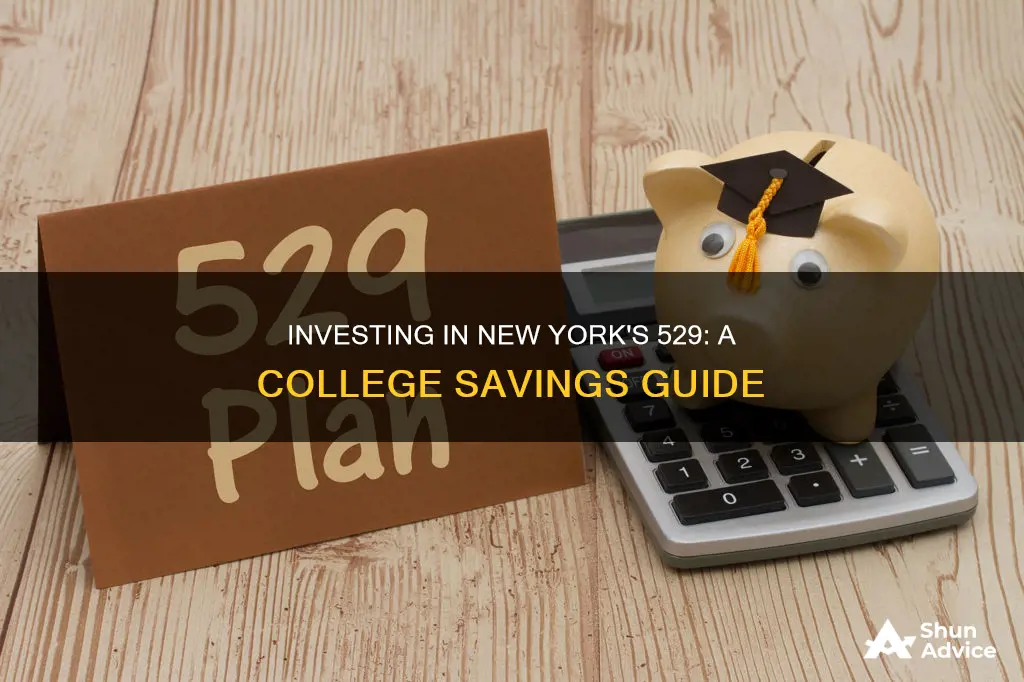
New York's 529 College Savings Program offers a tax-advantaged way to save for college. The program is designed to help families save for future college expenses, allowing them to contribute as little as $15 or as much as they want per investment option per pay period. It offers flexibility, with three age-based options and 13 individual portfolios to choose from. The program provides significant tax advantages, allowing assets to compound tax-free and withdrawals to be made tax-free for qualified education expenses. With recent changes to NY state law, the plan now offers more flexibility, allowing rollovers of up to $35,000 into a Roth IRA or up to $10,000 towards student loan repayments.
| Characteristics | Values |
|---|---|
| Investment account type | 529 plans |
| Tax benefits | Yes |
| Minimum contribution | $25 |
| Maximum contribution | $520,000 |
| Investment options | Age-based and individual portfolios |
| Tax-free withdrawals | For qualified higher education expenses |
| State tax deduction | Up to $5,000 for individuals, $10,000 for married couples filing jointly |
| Investment manager | The Vanguard Group, Inc. |
| Program manager | Ascensus College Savings |
| Investment advice | Available through the NY 529 Advisor-Guided College Savings Plan |
What You'll Learn

Tax advantages of the NY 529 plan
The NY 529 College Savings Program offers a range of tax advantages to its investors. Firstly, it allows you to save on taxes while saving for higher education. The money in your Direct Plan account grows tax-deferred, meaning you pay no income tax on earnings from federal and state income taxes. This allows for better growth potential over time compared to a taxable account.
Secondly, you can make tax-free withdrawals. You won't have to pay federal or state income taxes when you withdraw funds to pay for qualified higher education expenses at eligible educational institutions. This includes tuition, fees, room and board, books, supplies, and equipment for enrollment at any eligible post-secondary school worldwide.
Thirdly, you may be eligible for a New York State income tax deduction. If you're a New York State taxpayer and account owner, you can deduct up to $5,000 ($10,000 for married couples filing jointly) in contributions from your New York State income taxes each year. This further reduces your tax burden and encourages saving for college.
Additionally, the NY 529 Plan offers a federal gift tax incentive. You can contribute up to $18,000 per year ($36,000 for married filing jointly) without triggering federal gift taxes. This allows you to make substantial contributions without facing additional tax liabilities.
Lastly, the plan provides flexibility for out-of-state savers. Regardless of which state you live in, you can benefit from the tax advantages offered by the NY 529 Direct Plan. This makes it a viable option for those who want to take advantage of the plan's low costs and tax benefits, even if they don't reside in New York.
Invest Wisely to Secure Grandkids' College Education
You may want to see also

How to enrol in the plan
Enrolling in New York's 529 College Savings Program can be done online in a few minutes or by filling out a paper application and mailing it in. The program offers two types of plans: a direct-sold plan and an advisor-sold plan.
Direct-Sold Plan
The direct-sold plan is available to residents of any state and offers low fees and diverse investment options featuring Vanguard mutual funds. There is no minimum contribution required to start saving with the New York 529 College Savings Program, and you can contribute up to $520,000. The total asset-based fee is 0.13% for each portfolio, and there is no application fee or annual account maintenance fee.
To enrol in the direct-sold plan, you will need the following information:
- Social Security numbers or tax identification numbers
- Your bank account and routing numbers if making the initial contribution electronically
- The investment option or options you wish to select at the time of enrolment
Advisor-Sold Plan
The advisor-sold plan is sold only through financial advisors and offers the benefit of advice and expertise from an investment professional. This plan may result in higher fees, such as sales charges, to compensate the advisor.
To enrol in the advisor-sold plan, you will need to work with a financial advisor who can help you through the enrollment and investment selection process. It is recommended that you ask advisors about their qualifications, credentials, and fee structures before deciding on an advisor to work with.
Additional Information
Anyone can set up an account for a future college student, regardless of age, income, or state of residence. You can choose from three age-based options and 13 individual portfolios to manage your investment strategy. The program offers significant tax advantages, including tax-free withdrawals for qualified higher education expenses.
Maximizing HSA Savings: Investment Strategies for Tax-Free Growth
You may want to see also

Investment options
New York offers two types of 529 College Savings Plans, each with different investment options.
Direct-Sold 529 Plan
The Direct-Sold 529 Plan is available to residents of any state and offers low fees and diverse investment options featuring Vanguard mutual funds. There is no minimum contribution to start saving with this plan, and you can contribute up to $520,000. The total asset-based fee is 0.13% for each portfolio, and there is no application fee or annual account maintenance fee.
The Direct-Sold 529 Plan offers age-based and individual portfolios. The age-based portfolios automatically change their asset allocation to become less risky as the beneficiary approaches college age. You can choose a conservative or aggressive track for these portfolios, with the aggressive track investing a decent amount in stock funds and the conservative track focusing on bond funds and short-term reserves.
There are 13 individual portfolios to choose from, each investing in a single underlying mutual fund. These portfolios touch on all major asset classes and can be used to create a personalized investment strategy.
Advisor-Sold 529 Plan
The Advisor-Sold 529 Plan is sold only through financial advisors and offers the guidance of a professional financial advisor. This plan features funds from J.P. Morgan and other leading financial services firms, offering exposure to traditional and non-traditional asset classes, including real estate.
The cost of the Advisor-Sold 529 Plan depends on the portfolio and share class chosen, with fees including sales charges, annual account maintenance fees, and total annual asset-based fees. The share class can change over time, and certain classes carry lower fees, such as Advisor Class shares.
The Advisor-Sold 529 Plan offers age-based options and individual portfolios, similar to the Direct-Sold plan. The age-based portfolios are run by J.P. Morgan and offer exposure to different asset classes. There are also a variety of asset allocation portfolios that invest in various traditional and non-traditional asset classes from different fund companies.
National Saving Certificates: Smart Investment Strategies
You may want to see also

How to withdraw money
To withdraw money from the NY 529 College Savings Program, you must first log in to your account. From the "My Accounts" page, select the appropriate account, then choose "Make a Withdrawal" under "Investments" on the "Overview" page.
You will then be asked to select from a list of options, including:
- Qualified withdrawals for higher education expenses
- Withdrawals to pay fees, books, supplies, and equipment for an apprenticeship program
- Non-qualified withdrawals not used for education expenses
- Withdrawals to pay tuition for elementary or secondary school
- Withdrawals to pay principal or interest on a qualified education loan
If your withdrawal is going directly to a college or other post-secondary school, you will need to provide the beneficiary's student ID number.
After submitting your request, you must download, print, and complete the Withdrawal Request Form. Mail the completed form to:
New York's 529 College Savings Program Direct Plan
P.O. Box 55440
Boston, MA 02205-8323
If the withdrawal is going to a college or other post-secondary school, you will need to provide your account, beneficiary, and school information, as well as the beneficiary's student ID number.
Please allow ten business days, plus mailing time, for the funds to arrive. If you are adding or changing bank information, factor in an additional 15-day verification period during which assets cannot be sent to the bank.
Qualified vs. Non-Qualified Withdrawals
There are two types of withdrawals: qualified and non-qualified. Qualified withdrawals are used to pay for expenses such as:
- Tuition, fees, books, supplies, and equipment required for enrollment or attendance at an eligible educational institution
- Room and board expenses during academic periods when the beneficiary is enrolled at least half-time
- Expenses for students with special needs
- Purchase of computers or peripheral equipment, internet access, and certain software
- Tuition for elementary or secondary public, private, or religious school (K-12 tuition), up to $10,000 per year per beneficiary
- Fees, books, supplies, and equipment for an apprenticeship program registered with the Secretary of Labor
- Principal or interest on qualified education loans of the beneficiary or a sibling, up to a $10,000 lifetime limit per individual
Non-qualified withdrawals are any withdrawals that do not meet the criteria for qualified withdrawals. This includes withdrawals due to the death or disability of the beneficiary, receipt of a qualified scholarship by the beneficiary, rollover into a non-New York 529 plan, or transfer of assets to another beneficiary in a New York 529 plan.
Taxes on Withdrawals
You do not have to pay federal income taxes on qualified withdrawals from your account. However, earnings on non-qualified withdrawals are treated as income and are subject to federal and state income taxes, including a 10% federal penalty. Withdrawals due to the death or disability of a beneficiary or receipt of a scholarship are subject to ordinary income tax but not the 10% federal penalty.
For New York State taxes, you do not have to pay income taxes on distributions from your account if the funds are used for qualified higher education expenses at eligible educational institutions or apprenticeship expenses. However, distributions to pay K-12 tuition or qualified education loan repayments are considered non-qualified withdrawals and will require the recapture of any tax benefits that have accrued on contributions.
Maximizing Your Savings Account: A Guide to Smart Investing
You may want to see also

Direct vs advisor-sold plans
New York administers two types of 529 college savings plans: a direct-sold 529 plan and an advisor-sold 529 plan. The main difference between the two is that the former can be opened online and has lower fees, while the latter is available through licensed financial advisors who can offer professional guidance on college savings.
Direct-Sold 529 Plan
New York's direct-sold 529 plan has no minimum contribution requirement and offers lower fees compared to the advisor-sold plan. The total asset-based expense ratio for the direct-sold plan is 0.12%, one of the lowest available among 529 plans. The plan offers diverse investment options featuring Vanguard mutual funds, including age-based and multi-fund portfolios, as well as individual fund portfolios. The investment options cater to different risk levels, allowing investors to choose between aggressive, moderate, and conservative strategies. The direct-sold plan also ranks highly in performance, placing in the top 10 in Saving for College's quarterly performance rankings.
Advisor-Sold 529 Plan
New York's Advisor-Guided College Savings Plan is available through licensed financial advisors who can provide professional guidance on college savings. This plan has a minimum contribution requirement of $1,000 and offers a range of investment options featuring mutual funds from JP Morgan and State Street Global Advisors (SSGA). The advisor-sold plan provides access to a diverse investment menu, including age-based portfolios, multi-fund portfolios, and individual fund portfolios. The total asset-based expense ratio for the advisor-sold plan ranges from 0.28% to 1.99%, depending on the share class.
Key Differences
The main differences between the direct-sold and advisor-sold 529 plans in New York are the fees, investment options, and availability of professional guidance. The direct-sold plan offers lower fees and can be opened online, while the advisor-sold plan provides access to licensed financial advisors for professional guidance. The investment options also differ, with the direct-sold plan offering Vanguard mutual funds and the advisor-sold plan featuring JP Morgan and SSGA funds. The direct-sold plan has no minimum contribution, while the advisor-sold plan requires a minimum contribution of $1,000.
National Saving Scheme: Smart Investment Strategies
You may want to see also
Frequently asked questions
The NY 529 College Savings Plan is a type of investment plan that enables you to save money for a beneficiary to pay for higher education expenses. It offers low fees and diverse investment options.
The easiest way to enrol is online. You will need to gather the following information: Social Security numbers or tax identification numbers, and your bank account and routing numbers if making an initial contribution electronically. You will also need to select your investment option at the time of enrolment. Alternatively, you can fill out a paper application and mail it in.
New York State single filers can deduct up to $5,000 in annual contributions when calculating their New York state income tax. Married couples filing jointly can deduct up to $10,000 in contributions. All account holders can enjoy tax-exempt growth on their contributions. Withdrawals are also tax-free when used to fund qualified higher education expenses.
You can choose from age-based portfolios or individual options. Age-based portfolios automatically change their asset allocation to become less risky as your child reaches college age. Individual portfolios invest in a single underlying mutual fund.
You can request a withdrawal by logging into your account. Payments can be sent to you, your beneficiary, or the school they are enrolled in.







